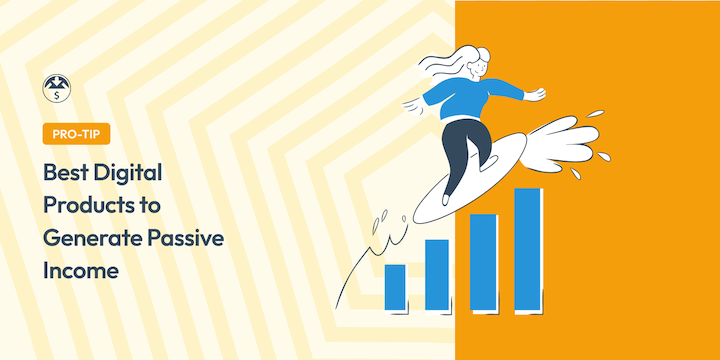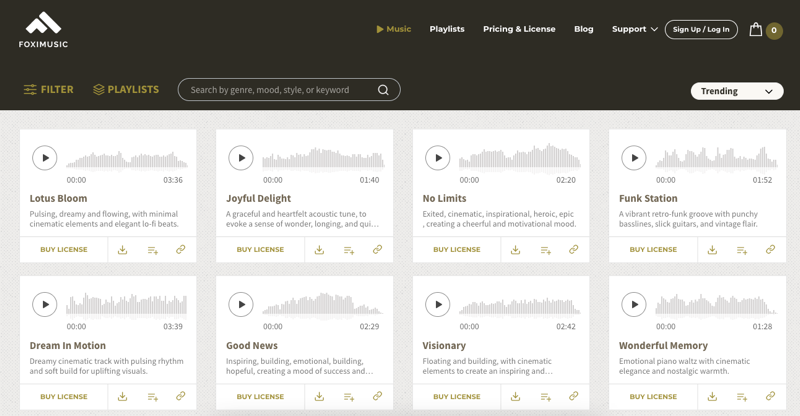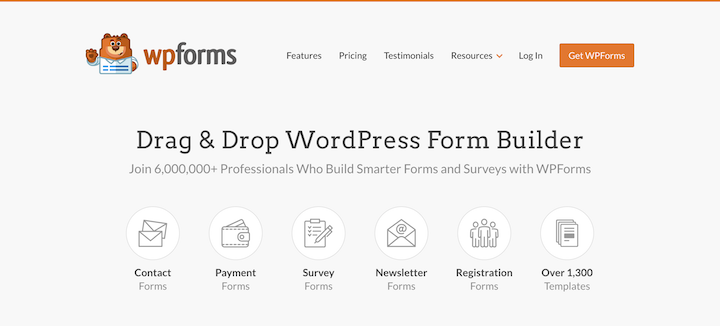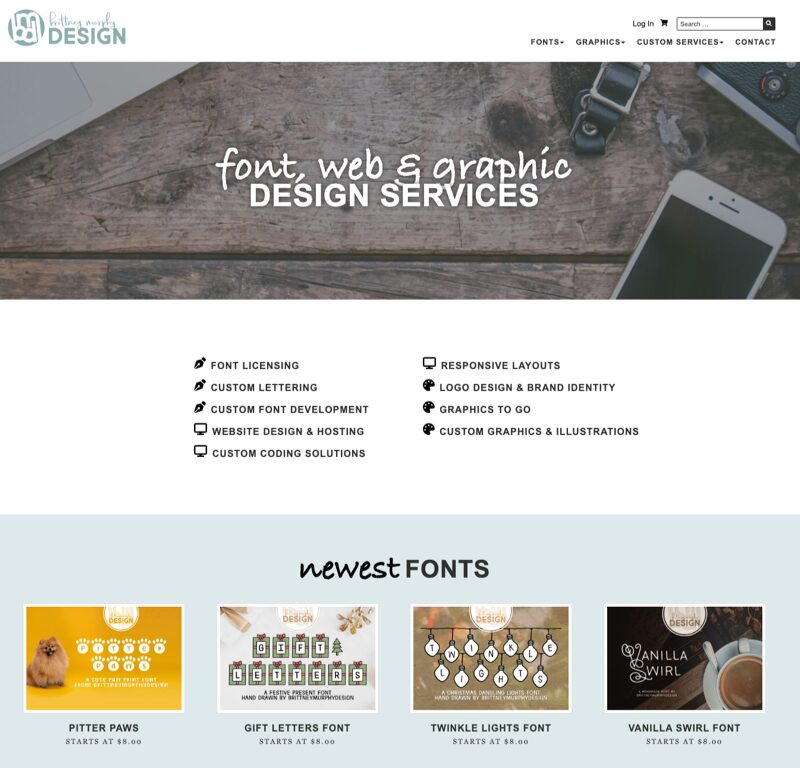
For many entrepreneurs, the path to building real freedom isn’t just about starting a business. It’s about finding the right digital product ideas to generate passive income.
This is how you break the cycle of trading time for money and stop the constant hustle for the next client or project.
The beauty of a digital product is its simplicity: you create it once and sell it over and over again. Best of all, you don’t need a huge budget or advanced technical skills to get started. All you need is your knowledge, a skill, or a creative spark turned into something valuable that people will pay for.
🔎 In this guide, I’ll share over 15 proven digital product ideas that work for creators.
Whether you’re a complete beginner or an established business owner searching for a new revenue stream, you’ll find an idea here to help you get started.
- What Is a Digital Product?
- 15+ Digital Product Ideas for Passive Income
- How to Choose the Right Digital Product
- Your 5-Step Roadmap (With Guides)
- FAQs on Digital Product Ideas & Passive Income
What Is a Digital Product?
A digital product (also known as a ‘digital download‘) is an intangible item you create once and can sell repeatedly. Examples include ebooks, online courses, software, templates, or digital art. Unlike physical goods, digital products eliminate the need for inventory management, shipping, or material costs, making them highly efficient.
This leads us to passive income. Let’s be clear: “passive” doesn’t mean “no work.”
It requires a significant amount of effort up front to create and market your product. But once that initial work is done, the system can largely run on its own, generating revenue with minimal ongoing effort.
The key benefits are a game-changer for any solopreneur or content creator:
- ✅ Low Overhead: No manufacturing or shipping costs. Your biggest investment is your time and skill.
- 📈 High Scalability: You can sell one copy or one million copies without your costs changing.
- 🌍 Global Reach: Your customers can be anywhere in the world, and they get instant access after purchase.
15+ Digital Product Ideas for Passive Income
Ready to find an idea that clicks for you? Here are over fifteen of the most profitable digital product ideas, grouped by the type of creator they’re best for.
- Educators & Experts
- Creatives & Designers
- Planners & Organizers
- Developers & Tech Experts
- Service Providers & Event Organizers
For Educators & Experts
1. Ebooks & Guides
An ebook is often the first digital product idea people think of, and for good reason. They are one of the simplest ways to package your knowledge. You can educate, advise, or curate content on any topic you’re passionate about.
For instance, ConvertKit founder Nathan Barry famously got his start by writing and self-publishing niche ebooks like The App Design Handbook.
- Best for: Writers, bloggers, coaches, and experts on any topic from gardening to coding.
- Pros: Low barrier to entry; you can write it in a standard word processor and establish authority in your niche.
- Cons: The market can be crowded, leading to lower price points due to a lower perceived value.
2. Online Courses & Workshops
If an ebook is a great starting point, an online course is the next level up. You can use video, audio, and text to offer a comprehensive learning experience that solves a significant problem for your audience
- Best for: Teachers, developers, artists, and anyone who can guide someone from Point A to Point B.
- Pros: High perceived value allows for premium pricing and can build a strong community around your content.
- Cons: Requires a significant time investment to create and may require video/audio equipment.

3. Membership Sites or Paid Newsletters
This model turns your knowledge and community into a recurring revenue stream by offering exclusive content to members who pay a monthly or annual fee. The key is providing consistent, high-value content that keeps subscribers engaged.
Journalists and experts use platforms like Substack to create premium, paid newsletters that provide exclusive analysis to a dedicated audience.
- Best for: Niche experts, community builders, and content creators with an established audience.
- Pros: Creates a predictable, recurring income and builds a loyal community.
- Cons: Requires consistent creation of new, valuable content to prevent churn.
4. Paid Communities & Masterminds
While similar to memberships, the primary product here is access to the community itself—a network of peers moderated by you. The value comes from the connections and shared knowledge within the group.
Pat Flynn’s “SPI Pro” is a thriving paid community where entrepreneurs connect, share advice, and learn from each other, facilitated by Pat and his team.
- Best for: Well-connected experts and natural community builders.
- Pros: Creates powerful network effects and high member loyalty with less pressure to constantly create new content.
- Cons: Requires active moderation and is difficult to start without a strong existing brand or audience.
For Creatives & Designers
If you have an eye for aesthetics and design skills, you can create digital assets that others can use to save time and produce beautiful work.
5. Templates & Presets
People love shortcuts! Templates for tools like Canva or Notion, presets for software like Adobe Lightroom, or themes for PowerPoint help customers achieve a desired result quickly and efficiently.
Designers build entire careers selling Canva templates for social media or Lightroom presets for photographers.
- Best for: Designers, photographers, productivity experts, and organization gurus.
- Pros: Quick to create if you’re an expert with the software and high demand in the creator economy.
- Cons: Tied to the popularity of specific software and may require customer support. Using marketplaces like Etsy (versus your own site) can come with limited control and high fees.

6. Stock Media (Photos, Videos, Music)
Are you a creative with a hard drive full of photos, video clips, or music tracks? You can turn that content into passive income by selling it as stock media.
This includes a wide range of digital product ideas, such as drone footage, musical samples, sound effects, and high-quality photographs.
- Best for: Photographers, videographers, musicians, and audio engineers.
- Pros: Leverages skills you already have and is truly passive once uploaded.
- Cons: Requires a large volume of assets to generate significant income, and marketplaces take a substantial cut.

7. Audio Products (Audiobooks, Meditations, etc.)
The demand for audio content is massive. This can range from recording an audiobook version of your ebook to creating guided meditations, affirmations, or audio courses.
Wellness coaches can bundle guided audio meditations, selling them as a package to help clients with stress or sleep.
- Best for: Writers, podcasters, wellness experts, and anyone with a good speaking voice.
- Pros: Taps into the popular audiobook market and is a great way to repurpose existing written content.
- Cons: Requires decent audio quality and recording equipment; editing can be time-consuming.
8. Printables & Digital Art
Printables are digital files that customers can download and print at home. Think checklists, calendars, wall art, and budget trackers. You can also sell original digital illustrations or graphic elements like icons and brushes.
Many successful shops focus solely on selling printable wedding invitation suites or children’s activity sheets.
- Best for: Graphic designers, artists, and anyone with a knack for organization and aesthetics.
- Pros: Fun and creative to make with very low creation costs (you can use tools like Canva).
- Cons: Individual items sell for low prices in a highly competitive market.

For Planners & Organizers
If you excel at creating systems and bringing order to chaos, you can sell tools that help others do the same.
9. Digital Planners & Journals
A distinct and booming niche, digital planners are interactive PDFs designed for use on tablets with apps like GoodNotes or Notability. They often feature hyperlinked tabs for easy navigation.
Countless creators find success selling hyper-niche digital planners, such as those tailored for students, small business owners, or fitness enthusiasts.
- Best for: Organized and design-savvy individuals who understand the tablet-based workflow.
- Pros: Extremely passionate customer base with high potential for repeat customers year after year.
- Cons: A very saturated and trend-driven market.
10. Spreadsheet Templates
Nearly every business and many individuals use spreadsheets. You can create and sell powerful templates for Microsoft Excel or Google Sheets that help people manage budgets, track projects, analyze data, or run their business.
A finance expert could sell a comprehensive personal budget dashboard or a sophisticated investment tracking spreadsheet.

eFinancialModels is an excellent example of offering this high-value niche product. The EDD-powered site sell complex and professionally-built financial model templates in Excel for startups, investors, and financial analysts.
- Best for: Finance pros, project managers, and data analysts.
- Pros: Taps into a huge existing user base (Excel and Google Sheets).
- Cons: Requires a deep understanding of spreadsheet formulas and functionality.
For Developers & Tech Experts
If you have coding and development skills, you can build powerful tools that solve critical problems for users.
11. Software, Plugins, or Themes
Developing software is a fantastic way to build a recurring revenue business. This could be anything from a WordPress plugin that adds a specific feature to a website, to a theme that controls its appearance, to a standalone app.
Our team at Awesome Motive has built a portfolio of successful businesses around WordPress plugins like WPForms and OptinMonster, which solve specific problems for millions of website owners.

- Best for: Developers and highly technical entrepreneurs.
- Pros: Can generate stable, recurring revenue and has a high barrier to entry (less competition).
- Cons: Requires significant technical skill and needs ongoing maintenance, updates, and support.
12. Web-Based Tools & Niche Calculators
Simpler than a full SaaS, this involves creating a useful online tool that solves one specific problem. You can offer it as a one-time purchase or behind a subscription.
A personal finance blogger could create a premium “Early Retirement Calculator” that offers more detailed projections than their free content.
- Best for: Developers and technical marketers who can identify a specific, repeatable problem.
- Pros: Can be highly automated once built and provides unique value that is difficult to replicate.
- Cons: May require coding knowledge or the budget to hire a developer.

For Service Providers & Event Organizers
You can “productize” your time and expertise, turning a service into a scalable digital offering.
13. Professional Services
This is often called a “productized service.” Instead of quoting on a case-by-case basis, you sell a fixed-price package with a predefined scope. This could be a “Logo Design Package,” a “Website SEO Audit,” or a “Series of 3 Coaching Calls.”
A copywriter could sell a “5-Page Website Copy Package” for a set price, which customers can purchase directly from their site just like any other product.
- Best for: Consultants, coaches, designers, copywriters, and virtual assistants.
- Pros: Creates predictable revenue and streamlines your workflow compared to custom-quoted projects.
- Cons: Less flexible than custom services; requires a very clear and defined scope of work.

14. Tickets for Events & Webinars
Tickets are a unique digital product because they grant access to an event, either virtual or in-person. You can sell tickets for online webinars, workshops, virtual conferences, or even livestreams of in-person events.
A marketing expert can host a paid, live 2-hour webinar teaching advanced SEO strategies.
- Best for: Public speakers, educators, and community organizers.
- Pros: Can be highly profitable and are excellent for building direct engagement with your audience.
- Cons: Tied to a specific date and time, and requires a platform to host the virtual event.
15. Documents & Case Studies
You are an expert in something. You can curate your knowledge into useful documents for sale. This could include industry reports, in-depth case studies, research papers, or legal templates.
A business consultant could sell a detailed case study on a successful marketing campaign, complete with templates and analysis.
Another example is ContractStore, which sells a huge library of professional legal contract templates.

They provide downloadable documents for various business and personal situations, productizing legal expertise into a scalable digital product.
- Best for: Researchers, analysts, legal professionals, and business strategists.
- Pros: Positions you as a leading expert in your field and can command high prices.
- Cons: Requires deep expertise and research to create something truly valuable.
How to Choose the Right Digital Product Ideas
Feeling overwhelmed? The perfect digital product ideas sit at the intersection of what you know, what people need, and what you enjoy doing.
Consider the following four key considerations.
| Key Consideration | Question | Guidance |
|---|---|---|
| 🧠 1. Expertise Intersect | What are my skills and passions? | Start with what you’re good at and what you love. Are you a great writer, a talented designer, a coding genius, or an amazing teacher? Your best product will leverage your existing talents. |
| ✅ 2. Market Need | What problem can I solve? | Your digital product ideas must solve a real problem for a specific audience. What do people in your niche struggle with? What shortcuts or results can you provide for them? |
| ⏳ 3. Effort Equation | How much time can I realistically invest? | Be honest. Creating an online course is a massive undertaking, while designing a simple printable checklist might only take an afternoon. Choose a product that matches your available time. |
| 🖌 4. Creation Preference | What format do I enjoy creating? | Your motivation will remain higher if you enjoy the creation process. For example, if you dislike being on camera, a video course might not be the best fit; an ebook could be a more natural and enjoyable choice if you love writing. |
Your 5-Step Roadmap (With Guides) 🗺
Okay, you’ve got your digital product ideas ready to go. Let’s make it a reality. Below is a simple five-step plan you can follow to bring your products to life and create passive income.
Step 1. Validate Your Digital Product Ideas Before Building
This is the most critical step. Don’t build something in a vacuum! You must confirm that people actually want and are willing to pay for your digital product ideas.
- Run Competitive Research: Browse marketplaces like Etsy, Gumroad, or Udemy. Are others successfully selling products similar to your idea? This is a sign of a healthy market.
- Survey Your Audience: If you have an email list or social media following, ask them directly. Run a poll or send a short survey to see if they struggle with the problem you aim to solve.
- Create a “Coming Soon” Waitlist: Set up a simple landing page that describes your future product and asks for an email address. A growing waitlist is a powerful indicator of interest.
- Pre-sell Your Product: This is the ultimate validation. Create a sales page for pre-orders and offer a special “early bird” discount to people who buy the product before it’s finished. If you get sales, you have a winner. If not, you’ve saved yourself hundreds of hours of work.
💡 Guide: How to Build a Digital Product Business for the Long-Term
Step 2. Create a Minimum Viable Product (MVP)
Your first version doesn’t need to have every bell and whistle. Focus on creating a high-quality, simple version that delivers on its core promise.
An ebook doesn’t need 30 chapters; start with 10. A template pack doesn’t need 100 templates; start with 20. You can add more later based on customer feedback.
Step 3. Build Your Storefront
Marketplaces like Etsy or Gumroad are tempting, but they come with high fees, fierce competition, and no real control. Your customers are their customers, not yours.
We always recommend building your own e-commerce store on a self-hosted WordPress site. It gives you 100% control over your branding, customer data, and—most importantly—your revenue.
For selling digital downloads on WordPress, nothing beats Easy Digital Downloads. Our team built it specifically for this purpose.

The core plugin is free and handles everything from your shopping cart to secure file delivery and payments via Stripe or PayPal. It’s the most powerful yet easiest way to sell digital products from your own website.
🔎 Still undecided on a platform? Use these guides
Step 4. Price Your Product
Don’t just look at competitors. Focus on value-based pricing.
How much is the transformation you’re providing worth to your customer? A template that saves them 10 hours of work is worth more than $5. An online course that helps them land a new job is worth hundreds or even thousands.
Price based on the value you deliver.
💡 Guide: Best Digital Pricing Models & Strategies
Step 5. Market & Automate Your Sales Funnel
Creating the product is only half the battle. You need a marketing strategy and system to attract customers and generate sales on autopilot.
- Content Marketing & SEO: This is the foundation of true passive income. By consistently creating helpful blog posts (like this one!) that your target audience is searching for, you bring a steady stream of free, organic traffic to your website.
- Email Marketing & Automation: Your email list is your most valuable asset. Create a lead magnet (a freebie like a checklist) to get subscribers, then set up an automated email sequence to build trust and pitch your product.
- Affiliate Marketing: Set up a program where other creators can promote your product in exchange for a commission on sales. This allows you to leverage the audiences of others to grow your reach exponentially.
FAQs on Digital Product Ideas & Passive Income
Let’s wrap up by answering some frequently asked questions on how to earn passive income selling digital products.
How much money can you make selling digital products?
The income you can make selling digital products ranges from a small side hustle to a full-time business, depending entirely on your product’s value, marketing effectiveness, and audience size.
Is income from digital products truly 100% passive?
No, income from digital products is not 100% passive. It requires significant upfront work to create and market, plus ongoing effort for customer support, marketing, and occasional product updates.
What are easy digital product ideas for beginners?
The easiest digital product ideas to create for a beginner are ebooks and simple printables. These products typically require minimal technical skill and can be created with free, user-friendly tools like Canva or Google Docs.
Do I need my own website to sell digital products?
While you can use marketplaces, having your own website gives you full control and higher profits. We strongly recommend using WordPress with a plugin like Easy Digital Downloads to own your platform.
How much does it cost to get started?
The cost to start selling digital products can be very low. If you use free creation tools and the free Easy Digital Downloads plugin, your only essential expense is website hosting.
Turn Digital Product Ideas Into Passive Income
Building a successful digital product takes work, but it’s one of the most rewarding ways to create new income streams. You’re packaging your unique knowledge into a scalable asset that can help people and generate revenue for years to come.
You don’t need to be a tech whiz or have a massive audience to start. If you have skill, a solution to a problem, and the drive to bring your digital product ideas to life, you’re all set.
Ready to take control? You can get started with Easy Digital Downloads for free today. If you’re serious about building a digital product empire, grab a Pro pass to unlock premium features and tools.
What’s Next? Check out our step-by-step guide on how to create a website to sell digital products.
📣 P.S. Be sure to subscribe to our newsletter and follow us on Facebook, Twitter/X, or LinkedIn for more WordPress resources!
Using WordPress and want to get Easy Digital Downloads for free?
Enter the URL to your WordPress website to install.
Disclosure: Our content is reader-supported. This means if you click on some of our links, then we may earn a commission. We only recommend products that we believe will add value to our readers.